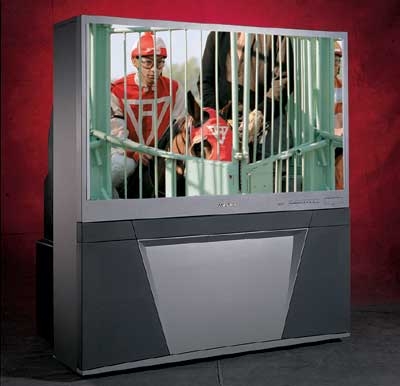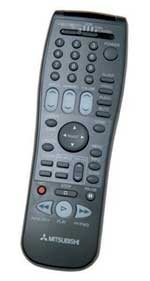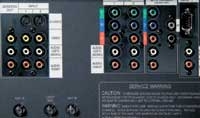3 Faces of HDTV Page 2
Mitsubishi WS-48315 You might think that tube-type HDTVs like Mitsubishi's WS-48315 are old workhorses ready to be put out to pasture, but tubes have two strong advantages: low price and great image quality. Plasma, LCD, and DLP sets can't yet match the solid blacks and rich shadow detail of CRT models, which deliver those benefits at about half the price of competing types. 
|
The WS-48315 sports a flat gray cabinet with a wedge-like indentation that provides a neat visual counterpoint to the expansive screen above it. Along with a front A/V input, there are a smattering of controls visible on the front panel, including buttons to cruise menus, switch inputs, and change picture-display modes. And the spacious top surface can easily accommodate a center-channel speaker.
Connections include three component-video inputs and a DVI (Digital Visual Interface) jack with HDCP (High-bandwidth Digital Content Protection) copy protection. The remote control fits snugly in your hand and sports a few backlit buttons. It includes controls to toggle up and down through the set's inputs, tweak picture adjustments without wading through an onscreen menu, and switch display format (aspect ratio). Along with standard 4:3 and widescreen 16:9, the format choices include four zoom and stretch modes. All work with regular TV and progressive-scan DVD, but only the Expand mode works with HDTV programs.
 A 64-point user convergence control helped me achieve an extremely crisp alignment of the Mitsubishi's red, green, and blue tubes. Also useful were Color Balance and Input Assignment, which let me delete unused connections from the input-selection list. Unique to Mitsubishi TVs, Color Balance lets you individually fine-tune red, green, blue, and other colors. Using these controls, I was able to surgically remove a reddish tint in the picture without disturbing its overall color balance. Although the TV lacks the sort of factory picture presets you find on other TVs - like Movie and Sports - you can create and save a custom preset for each of its video inputs. This lets you optimize the picture settings for specific video sources - for example, a DVD player and a high-def cable box.
A 64-point user convergence control helped me achieve an extremely crisp alignment of the Mitsubishi's red, green, and blue tubes. Also useful were Color Balance and Input Assignment, which let me delete unused connections from the input-selection list. Unique to Mitsubishi TVs, Color Balance lets you individually fine-tune red, green, blue, and other colors. Using these controls, I was able to surgically remove a reddish tint in the picture without disturbing its overall color balance. Although the TV lacks the sort of factory picture presets you find on other TVs - like Movie and Sports - you can create and save a custom preset for each of its video inputs. This lets you optimize the picture settings for specific video sources - for example, a DVD player and a high-def cable box.
PICTURE QUALITY After selecting the Low 6500K color-temperature setting and making some additional tweaks via the set's hidden service menu (see "in the lab," page 48), I cued up the Seabiscuit DVD on my progressive-scan player. The color was extremely well balanced, with the more garish hues - like Red Pollard's crimson jockey uniform - looking vivid alongside the subdued shades of the landscape and the other actors' Depression-era clothing. Skin tones were natural, and plenty of background detail was visible in dark shots. For example, in a scene where the owner of the horse War Admiral holds a press conference, the wide range of shades in the reporters' black and gray clothing was plainly visible.
 The Mitsubishi also put on a good show with high-def programs. In a Timberwolves vs. Lakers game on the new high-def TNT channel, the bright blues and yellows of the players' uniforms dramatically popped out against the natural wood tone of the court. Basketball is particularly well served by HDTV. There was a lifelike sense of depth to the image, and when the Lakers' Gary Payton spun around mid-court and dropped a long shot into the basket, the entire field of action came across on the expansive screen. Picture detail seemed a notch below the other two sets, but it was good enough that I could spot Jack Nicholson in the crowd without benefit of a closeup.
The Mitsubishi also put on a good show with high-def programs. In a Timberwolves vs. Lakers game on the new high-def TNT channel, the bright blues and yellows of the players' uniforms dramatically popped out against the natural wood tone of the court. Basketball is particularly well served by HDTV. There was a lifelike sense of depth to the image, and when the Lakers' Gary Payton spun around mid-court and dropped a long shot into the basket, the entire field of action came across on the expansive screen. Picture detail seemed a notch below the other two sets, but it was good enough that I could spot Jack Nicholson in the crowd without benefit of a closeup.
The Mitsubishi was prone to "hotspotting," an ailment that's common to CRT-type rear-projection TVs. When I moved more than a couple of feet off center, the picture became noticeably dimmer. Also, this TV performs best when paired with a progressive-scan DVD player. The picture looked somewhat noisy and soft with my player switched to its interlaced output. When I switched back to progressive-scan mode, it looked fine.
At $1,700, Mitsubishi's WS-48315 is a great value. It offers very good video performance and can look even better with a bit of tweaking. I strongly recommend this TV to movie fans who watch lots of DVDs and seek a truly cinemalike experience. And when high-def basketball looks that good . . . well, that's just icing on the cake.
PDF: Features Checklist PDF: In the Lab














































